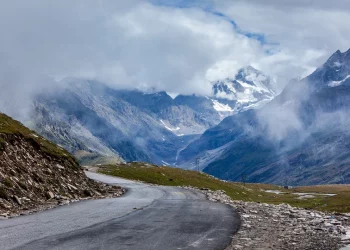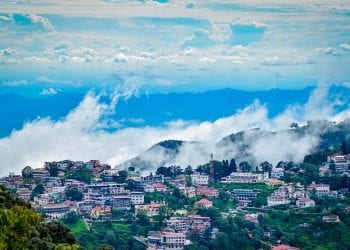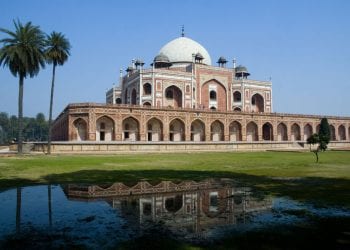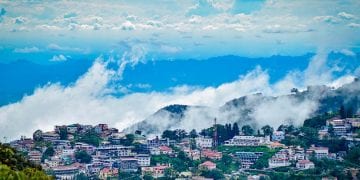9 Temples in Ahmedabad that Will Leave You Spiritually Spellbound
Ahmedabad, the bustling city of Gujarat, will fascinate you in more ways than you can imagine. If you thought it is all about garba, colourful textiles or yummy Gujarati cuisine, then you need to visit this culturally diverse city to discover so much more. As you walk through the streets of Ahmedabad, it will win you over with its amazing architecture, centuries-old mosques, ancient temples, and contemporary buildings. While the narrow streets of the old part of the city will excite you, the new city has world-class restaurants, bustling shopping centers, and malls. The old city is situated on the eastern side of the Sabarmati River and is surrounded by a 10-kilometer long wall. While the new city lies on the western side of the river and has several universities and new dwellings.
Ahmedabad, which is also known as Amdavad, Ahmadabad or Ahemdavad exhibits a confluence of cultures. This is because this vibrant city of Gujarat has been under the rule of different dynasties like Delhi Sultanate, Mughals, Marathas, and the British. Under the rule of each of these dynasties, there has been much added to its history and culture in the form of temples and monuments. So, let us get to know more about this largest city of Gujarat – Ahmedabad by exploring some of its famous temples.
Top 9 Temples To Visit In Ahmedabad
- Akshardham Temple
- Swami Narayan Temple
- Hutheesingh Temple
- Modhera Sun Temple
- Shri Hanumanji Temple
- BhadrakaliMaa Temple
- Shree Jagannath Temple
- Devendrashwar Mahadev Temple
- Vaishno Devi Temple
1. Akshardham Temple
You should start your Ahmedabad trip with this temple. It is one of the largest temples of Gujarat and is spread over 23 acres of land. Lord Swaminarayan is the presiding deity of this temple. It is built using 6000 tons of pink sandstone. A true architectural marvel, the temple is a perfect amalgamation of art, culture, and devotion. It has an intricately carved structure of Lord Swaminarayan, which stands tall in the sprawling lawns of this beautiful temple.
The Akshardham Temple is surrounded by a garden – Sahajanand Van. There are horse rides, games, swings for kids, a herbal garden, a lake, and a waterfall. Besides, there are also three exhibition halls to educate visitors. There is also a Sat-Chit-Anand water show that takes place in the temple premises. It beautifully showcases India’s inner light story through the story of Nachiketa.
A visit to this temple is a must not only for devotees but even for those who pose a nose for architecture. The many attractions within the temple ensures a huge footfall. According to the last census, 2 million people visit this temple every year. It is located around 25kilometres from the city centre. One of the popular religious spots, it is a true architectural marvel. If you really wish to see the temple fully decked up, then plan a visit here during the festivals of Janmashtami, Diwali, and Navratri.
2. Swami Narayan Mandir
The land where this mandir was constructed was gifted by the British Imperial Government and the construction was entrusted by Lord Swaminarayan to Ananandand Swami. This temple was constructed according to scriptural norms with pure Burma teak carvings. Even the installation ceremony of the murtis was done in the presence of thousands of pilgrims from across the country.
The God in the main temple complex is in the form of a child – Ghanshyam Maharaj. It is installed in the Akshar Bhavan where the personal items of Swaminarayan have been put for display and hence can be viewed by pilgrims and visitors. There is also an idol of Ghanshyam Maharaj in Rang Mahal where Swaminarayan lived during his visits to Ahmedabad. Besides this, there is also a house of sculptures of Swaminarayan in the mandir.
Visit this mandir, which gives the feel of being in a Gujarati mansion. There are nine tombs on the southern part, which are referred to as “Nau Gaz Pir”. The architecture of this temple is truly one of its kind and you should visit here during any Hindu festival to experience the place in its full glory. The beautiful domes, lush green gardens, and magnificent architecture will keep bringing you back.
3. Hutheesingh Temple
This Jain temple was built in 1848 and is dedicated to Dharamanath (the fifteenth Jain Tirthankara). Besides, there are 52 sub-shrines in the courtyard that are dedicated to various other Tirthankars. There are large protruding porches, decorated columns, and figural brackets on the three outer sides. There is also a 78-feet tall Mahavir Stambha near the front entrance. In fact, some of the motif designs are inspired by the Sultanate minarets of the Mughal period.
A remarkable temple, it is made using white marbles, which is sacred to Jains. This temple was built by a rich Jain merchant, Sheth Hutheesing as a dedication to the Shri Dharamanath. He had spent around 10 lakh rupees for constructing this marvellous religious site. The traditional artisans working in stone were mainly from Sonpura and Salat communities. This masterpiece is attributed to Premchand Salat of the Salat community.
It is located outside the Delhi Gate and is spread over a huge courtyard, the mandapa is surrounded by huge domes and 12 decorated pillars. The main shrine is referred to as a small garbhagruh and is situated on the east side of the temple. Throughout the temple, there are beautiful hand carvings, which have been intricately done by the designers. A visit to this Jain temple along with other religious sites will be totally worth it as it is one of the most beautiful temples in Ahmedabad.
4. Modhera Sun Temple
This temple is dedicated to the Sun God and is one of the most popular tourist sites. The architecture of this temple is truly unique and well-designed. There are three mandaps inside this temple. The Guda mandapa is considered the main one. The two other mandapas include the Kunda and Sabhamandapa. The temple is symbolic of the ancient times when people revered the natural elements of fire, air, water, earth, and sky. Moreover, a walk around this temple will give you a serene feeling as there is a positive aura about this place.
The Modhera Sun Temple is symbolic of the Solanki period, which is also referred to as the Golden Age of Gujarat. The beautifully carved temple and the kund, which is sculpted reflect the intricate artwork of the masons of the Solanki period.
At present, there is no presiding deity in this temple, and it is a protected monument. It is being maintained by the Archaeological Survey of India. You will easily end up spending around two hours in this temple and you should ideally visit here between the months of October to March.
When you enter this historical complex, you will see a huge kund – the Ramakund, which is rectangular in shape and has 108 shrines of different gods and demi-gods. Then, you must see the three main shrines each located on the three sides of the kund. The three shrines are that of Lord Ganesh, Lord Vishnu, and Lord Shiva doing tandav and facing the temple. Then, there is also the Sabha Mandap or the assembly, which has sculpted renderings of the twelve Adityas (name of Sun god). Moreover, you must also find a purohit or priest who will have lots of stories to narrate about this religious site.
5. Shri Hanumanji Temple
It is one of the most beautiful temples in Ahmedabad, which is dedicated to Lord Hanuman. This temple is in the Cantonment Area on the airport road in Shahibaug. It was established by Pandit Gajanan Prasad and is a hundred-year-old temple. It is one of the most popular temples where people come from faraway lands to seek the blessings of Lord Hanuman. This temple is one of the biggest in India and is believed to have powers to help people get rid of their problems.
The temple has a gold-plated statue of Lord Hanuman and is surrounded with writings of Lord Rama. Lord Hanuman was a devotee of Lord Rama. Besides, there is also the mace placed near the image of the idol. Even after all this set-up the inner sanctum is huge enough to accommodate devotees in large numbers and they can comfortably offer prayers or chant religious songs.
The temple has a huge footfall on Tuesdays and Saturdays. The most popular festivals that are celebrated in this temple are Hanuman Jayanti and Sri Ram Navami. So, if possible, you should plan a visit to this famous temple during these Hindu festivals. Along with this temple, one can also cover the Mahalakshmi Temple and Mankameshvar Temple. These are also popular religious sites in Ahmedabad.
6. BhadrakaliMaa Temple
The presiding deity of this temple is Maa Bhadrakali, which is a form of Goddess Kali. An ancient temple it is believed to have been constructed during the reign of Ahmed Shah in the 14-century. It is one of the oldest temples in Ahmedabad and is quite popular even among the locals.
The festival of Navratri is celebrated here with much gaiety. It is one of the best times to visit this temple when there are traditional Gujarati tunes, dance, and food fest organised at the temple. The other main attraction of this temple is that the vehicle of the goddess is changed here every day.
7. Shree Jagannath Temple
The place where this temple is built was earlier covered by thick forest and the Sabarmati River used to flow here. At present, there is the beautiful Jagannath Temple on this Jamalpur road of Ahmedabad.
This temple is dedicated to Lord Jagannath and will mesmerise you with its architectural beauty. The most popular festival celebrated here is the Rath Yatra. It is the annual chariot festival, which is celebrated with much fervour. The celebration of Rath Yatra started here in 1878 and since then celebrated every year. Even other Hindu festivals are celebrated in this temple like Janmashtami, Diwali, and Guru Purnima. There is also a Panchakarma Ayurveda hospital inside the campus.
8. Devendrashwar Mahadev Temple
It is one of the most holy and popular religious sites in Ahmedabad. The temple is dedicated to Lord Mahadev. It also has a beautiful idol of Goddess Durga and the architecture is also noteworthy. It has the capacity to accommodate a large number of people and a lot of people visit this temple every day.
The festival of Mahashivratri is celebrated with much fervour and it is the best time to visit this temple. There is also a river on the backside of this temple from where you can enjoy a panoramic view.
9. Vaishno Devi Temple
It is located on the Gandhinagar road and is one of the best temples in Ahmedabad. This temple is a replica of the Mata Vaishno Devi Shrine in Jammu & Kashmir. It has been made on a man-made hill and one needs to climb up the hill to visit this temple. You should visit here during the festival of Navratri. All the nine days of the festival are celebrated here with much enthusiasm. There is also a Tirupati Balaji Temple nearby, which you can cover when visiting this temple.
There are many old and new temples, which are worth visiting in Ahmedabad. The beautiful city has amazingly restored structures from the past while developing new and colourful temples. You can get to know a lot about the history, culture, and heritage of Gujarat by visiting the many temples in Ahmedabad. Try to cover the ones mentioned in the list above and have an epic Ahmedabad trip.
P.s. You might like these related resources:
- Awesome places to visit in Ahmedabad which will leave you awestruck
- Places to visit near Ahmedabad that shouldn’t be missed
- Planning a trip to Ahmedabad? Here’s a sneak peek of Ahmedabad weather and the best time to visit the Manchester of the East
Recent Posts
Top Picks

- OYO
 15 April, 2024
15 April, 2024 - Cultural Tour

- OYO
 15 April, 2024
15 April, 2024 - Cultural Tour

- OYO
 15 April, 2024
15 April, 2024 - Cultural Tour

- OYO
 15 April, 2024
15 April, 2024 - Cultural Tour

- OYO
 15 April, 2024
15 April, 2024 - Cultural Tour

Please rotate your device
Please go back to portrait mode for the best experience




 April 15, 2024
April 15, 2024 



